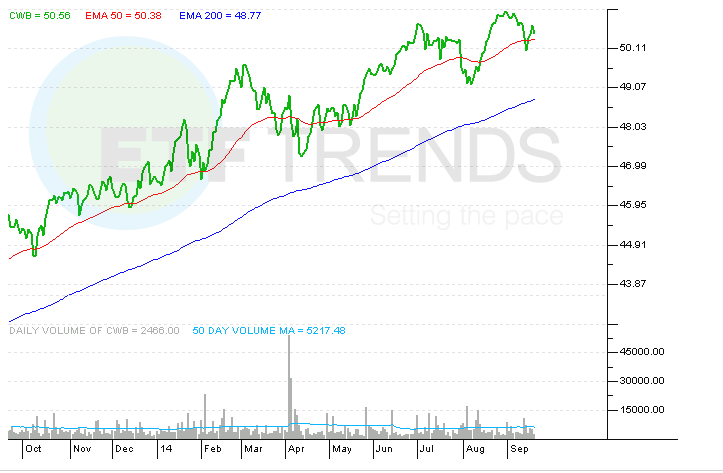It Could be Time to Call on the Convertibles ETF Again
Ten-year Treasury yields are off 13.3% this year, but that has not stopped the SPDR Barclays Convertible Securities ETF (CWB) from posting a respectable gain of 8.5%.
CWB’s 2014 performance underscores the often intimate correlations between convertible bonds and equities. Last year, the ETF’s utility as a prime rising rates play was on full display. As 10-year yields surged, so did CWB. In 2013, CWB climbed 20.5%, a stellar move for a bond ETF in an overt equity bull market.
That serves as a reminder that convertible bonds are often the top-performing fixed income asset class in rising rate environments, as SSgA Vice President and head of research Dave Mazza noted in an interview with ETF Trends from the Morningstar ETF Conference in Chicago. [Bond Ideas for the Next Rate Cycle]
As Mazza points out, an interesting scenario is developing with CWB and professional investors’ attitude toward the ETF.
“Clients are not viewing convertibles as a fixed income replacement,” he said. “Some inflows to CWB are coming from equities with clients selling small-caps in favor of CWB for lower volatility and a higher yield.”
Convertible bonds can be looked at as “best of both worlds” securities. Since the bonds can be converted into stock of the issuer, convertibles are often more intimately correlated to equities than other segments of the bond market. But like bonds, convertibles promise coupon payments and return of principal at a set date. [Convertibles ETF Now Holds Tesla Bonds]
Despite the equity-like properties, CWB sports a dividend yield of 3.12%,which is 135 basis points above the S&P 500, but well below the yields on many junk bond ETFs. Though not a true high-yield ETF, 34% of CWB’s holdings are rated below Baa while a combined 34.3% are rated A or Baa.
Passively manged, CWB offers a solid alternative to the raft of actively managed convertibles mutual funds available on the market.
“The spectrum of actively managed convertibles funds leads to a lot of different returns,” notes Mazza. “We see clients leaving active funds for CWB. The average fee on an actively managed convertibles fund is at least double that of CWB.”
CWB, the lone dedicated convertibles ETF on the market today, charges 0.4% per year.
Speaking of arrivals to CWB, which could be a sign some investors are expecting interest rates to rise, there have been plenty this year. The ETF, an expected area of growth for State Street, the second-largest U.S. ETF sponsor, has delivered on that promise. CWB now has nearly $3 billion in assets under management after pulling in $771.3 million in new assets this year.
That is better than the combined $3.8 billion pulled from the two largest junk bond ETFs. Adding some validity to the notion that investors have dumped small-caps in favor of CWB, the iShares Russell 2000 ETF (IWM) has lost $2.2 billion while lagging CWB in terms of performance.
SPDR Barclays Convertible Securities ETF
Tom Lydon’s clients own shares of IWM.

